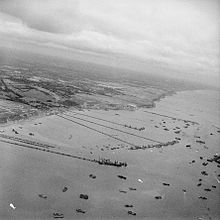
Back Мълбери Bulgarian Port Mulberry Catalan Mulberry-havn Danish Mulberry-Häfen German Λιμένες Μάλμπερι Greek Puerto Mulberry Spanish Mulberry sadam Estonian بندرگاه مالبری Persian Port Mulberry French Cé Maoildeirge Irish
| Mulberry harbour | |
|---|---|
 View of the Mulberry B harbour "Port Winston" at Arromanches in September 1944. Centre and left are "spud" pierheads with floating piers of "whales" and "beetles". At right is 2,000 ft (610 m) of "Swiss roll".[1] | |
| Location | |
| Location | Arromanches and Omaha Beach, Normandy, France |
| Coordinates | 49°20′51″N 0°38′02″W / 49.3475°N 0.6340°W |
| Details | |
| Opened | June 1944 |
| Closed | March 1945 |
| Type | Temporary portable harbour |
| Purpose | Military equipment, stores and personnel |
| Joins | Beach |
The Mulberry harbours were two temporary portable harbours developed by the British Admiralty and War Office during the Second World War to facilitate the rapid offloading of cargo onto beaches during the Allied invasion of Normandy in June 1944. They were designed in 1942 then built in under a year in great secrecy; within hours of the Allies creating beachheads after D-Day, sections of the two prefabricated harbours were towed across the English Channel from southern England and placed in position off Omaha Beach (Mulberry "A") and Gold Beach (Mulberry "B"), along with old ships to be sunk as breakwaters.
The Mulberry harbours solved the problem of needing deepwater jetties and a harbour to provide the invasion force with the necessary reinforcements and supplies, and were to be used until major French ports could be captured and brought back into use after repair of the inevitable sabotage by German defenders. Comprising floating but sinkable breakwaters, floating pontoons, piers and floating roadways, this innovative and technically difficult system was being used for the first time.
The Mulberry B harbour at Gold Beach was used for ten months after D-Day, while over two million men, four million tons of supplies and half a million vehicles were landed before it was fully decommissioned. The partially completed Mulberry A harbour at Omaha Beach was damaged on 19 June by a violent storm that arrived from the northeast before the pontoons were securely anchored. After three days the storm finally abated and damage was found to be so severe that the harbour was abandoned and the Americans resorted to landing men and material over the open beaches.
- ^ Murchie 1993, p. 4.